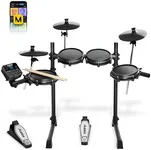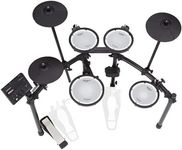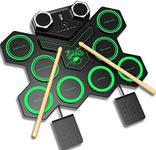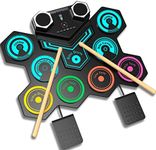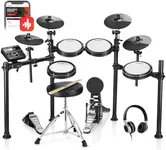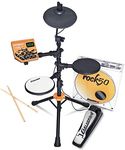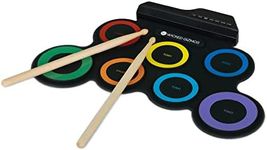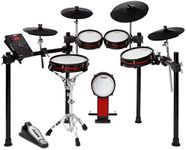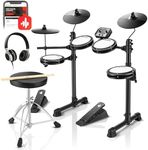Buying Guide for the Best Electric Drum Kits
Choosing the right electric drum kit can be a rewarding experience, especially if you know what to look for. Electric drum kits are a fantastic option for drummers who need a quieter practice solution, want to experiment with a variety of sounds, or have limited space. When selecting an electric drum kit, consider your skill level, the space you have available, and the type of music you want to play. Understanding the key specifications will help you make an informed decision that suits your needs and enhances your drumming experience.Drum PadsDrum pads are the surfaces you hit to produce sound, and they can vary in size, material, and sensitivity. The material can be rubber or mesh, with mesh offering a more realistic feel similar to acoustic drums. Sensitivity is important because it affects how well the pads respond to your playing dynamics. Beginners might be fine with rubber pads, while more advanced players may prefer mesh for its responsiveness and feel. Consider what feels comfortable and realistic to you, and think about the type of music you will be playing.
Sound ModuleThe sound module is the brain of the electric drum kit, containing the sounds and effects you can use. It determines the variety and quality of sounds available, from different drum kits to percussion instruments and special effects. Basic modules offer fewer sounds and features, which might be sufficient for beginners. More advanced modules provide a wider range of sounds and customization options, which can be beneficial for experienced drummers or those who want to experiment with different genres. Consider what sounds you need and how much customization you want.
ConnectivityConnectivity refers to the ability of the drum kit to connect with other devices, such as computers, smartphones, or amplifiers. This is important for recording, playing along with music, or using educational apps. Basic kits might only have headphone and auxiliary inputs, while more advanced kits offer USB or MIDI connectivity for more extensive integration with digital audio workstations (DAWs) and other software. Think about how you plan to use your drum kit and what devices you want to connect it to.
PortabilityPortability is about how easy it is to move and set up the drum kit. This can be important if you have limited space or need to transport the kit frequently. Some kits are designed to be compact and lightweight, making them easier to store and move. Others might be more robust and heavier, offering a more stable playing experience. Consider your space constraints and whether you need to move the kit often when deciding on portability.
DurabilityDurability refers to how well the drum kit can withstand regular use and transport. This is important for ensuring the longevity of your investment. Kits made with higher quality materials and construction tend to last longer and perform better over time. If you plan to use the kit frequently or transport it often, look for one with a reputation for durability. Consider how often you will use the kit and in what environments to determine the level of durability you need.





